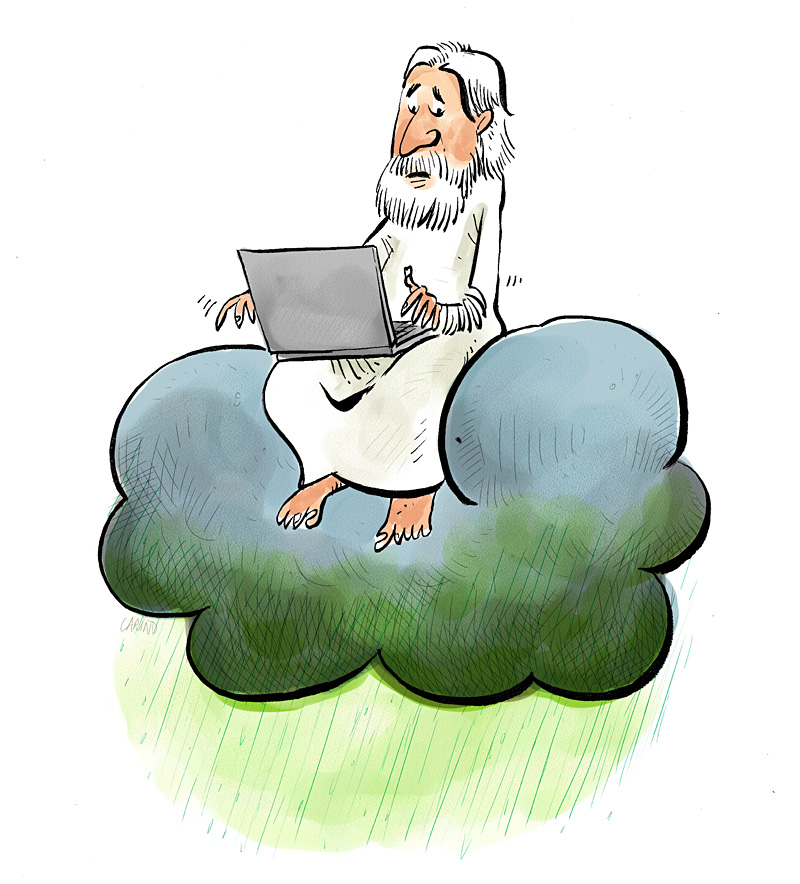Greenpeace activists are nothing if not determined. If the cause calls for it, they’ll break out the rappelling gear and get down to action—as they did last Thursday at Amazon’s headquarters in South Lake Union, hoisting an 800-square-foot cloud-shaped banner to protest the dirty energy that Greenpeace says Amazon and Microsoft use to power their cloud-computing services. The banner read: “Amazon, Microsoft: How Clean Is Your Cloud?”
Cloud computing means using a network of remote servers hosted on the Internet to store, manage, and process data. Every time you upload a picture, song, video, or anything else, that digital information has to be stored somewhere, and cloud-computing data centers—typically giant buildings with massive computer servers that require loads of electricity to operate—are where it all goes.
The issue at hand is where companies like Amazon and Microsoft choose to locate their cloud data hubs and what kind of power is used to run them. For instance, hubs in Hong Kong are heavily powered by coal, while those in Sweden are less so. Things like temperature and access to reliable, affordable electricity play into a company’s decision where to locate them. There are now cloud-computing data centers all around the world. Microsoft, for instance, recently announced plans to build a new cloud-computing data center in Wyoming.
Last week’s Greenpeace protest was part of an overarching campaign by the environmental watchdog organization, responding to a recently released study indicating that 34 percent of the electricity used by Amazon comes from coal-generated power and 30 percent from nuclear, while Microsoft uses 39 percent coal power and 26 percent nuclear. Amazon calls the report’s data and assumptions inaccurate.
“These are really influential companies that have a great deal of potential for leadership,” says Greenpeace Media Officer David Pomerantz. “They have massively large and very quickly growing cloud infrastructure, and if they continue to do the wrong thing, it will push the sector that way, and if they make a change and do the right thing and choose to go down a clean-energy pathway, it will push the industry in the right direction.”
“When they improve the impact will be really, really great,” offers Greenpeace IT Analyst Casey Harrell, a co-author of the organization’s report.
Microsoft’s response to Greenpeace’s actions: “Microsoft works hard to drive efficiency and sustainability across our operations, including our data centers. Our latest modular data centers use about 50 percent less energy than those from three years ago, and only 1 percent of the water used by traditional data centers in the industry. On April 16, the company announced that it had reached its goal of reducing carbon emissions by 30 percent per unit of revenue below its 2007 baseline. We engage with a wide range of environmental sustainability advocates, including Greenpeace, to inform our efforts to reduce our environmental impact.”
“As we communicated to this researcher several weeks ago, we don’t disclose this information publicly, but his data and assumptions about Amazon are inaccurate,” Amazon Public Relations’ Tera Randall says. “Amazon Web Services believes that cloud computing is inherently more environmentally friendly than traditional computing. Instead of each company having their own data center that serves just them, AWS makes it possible for hundreds of thousands of companies to consolidate their data-center use into a handful of data centers in the AWS Cloud, resulting in much higher utilization rates and eliminating the waste that occurs when data centers don’t operate near their capacity. The cloud enables a combined smaller carbon footprint that significantly reduces overall consumption.”
Harrell says Greenpeace’s approach was created to appeal to Amazon and Microsoft employees, noting that many of them are “value-aligned” with Greenpeace’s message.








